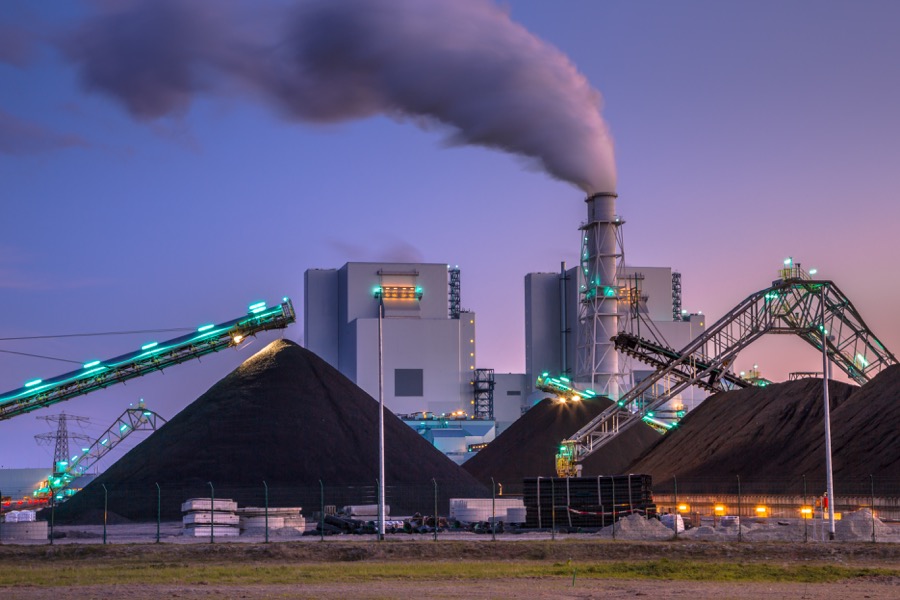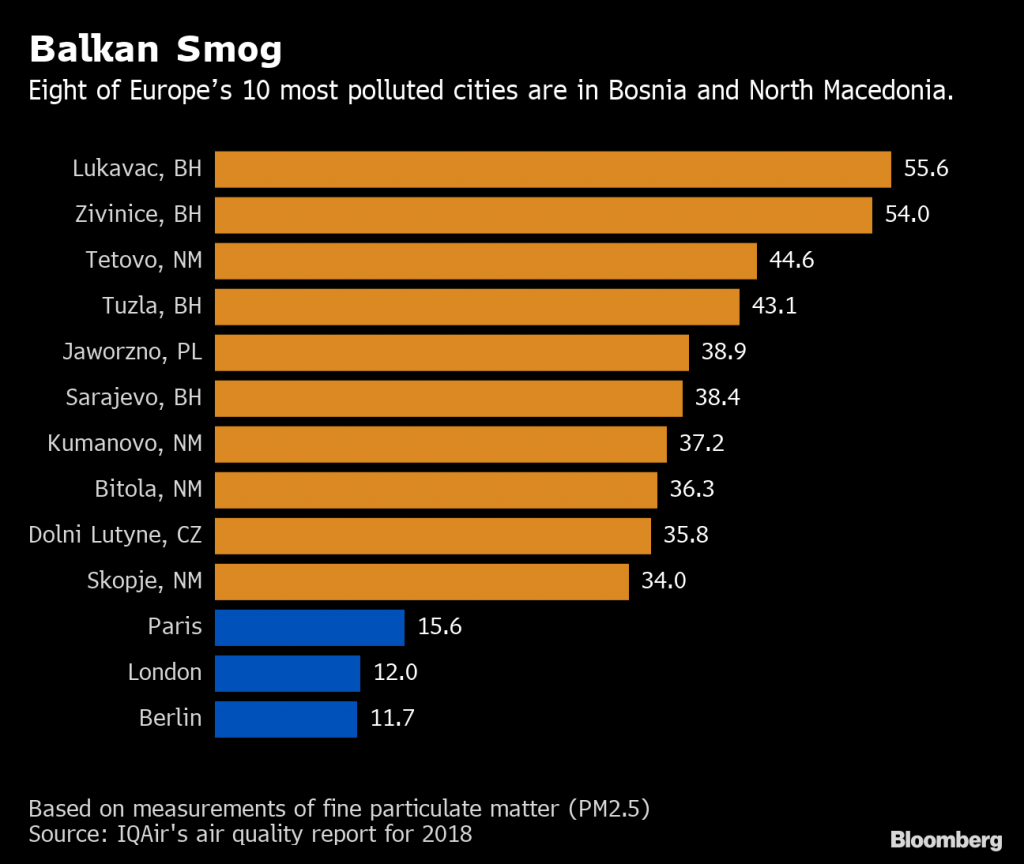
Ruzica Simic spends her spring mornings sweeping coal dust off her garden path. It’s almost a daily chore, but preferable to the black snow that falls in winter. That’s when even breathing becomes laborious, she says.
Such is life in the dirtiest corner of Europe, a continent still cleaved along its old Cold War fault line when it comes to the environment. While the campaign against climate change is now firmly part of the political mainstream in the west, next door a toxic souvenir from communism continues to blight lives.
Simic lives in a village outside Tuzla, a city in the former Yugoslav state of Bosnia-Herzegovina that’s a mere 315 kilometers (200 miles) from the border with Austria, a pioneer of clean energy. Bosnia, North Macedonia and Serbia, struggling with poverty and corruption and the legacy of devastating civil wars of the 1990s, are Europe’s most polluted nations as well as among its poorest.
For a few days last winter, the Bosnian capital of Sarajevo had the world’s dirtiest air, worse than Beijing, according to activists. When the coal-fired power plant 200 meters away from Simic’s cottage fills the sky with pollution, it floats as far away as Italy. Water poisoned with carcinogens trickles along an open culvert past her chicken coop.
“Almost everyone living here has health problems—many have cancer, almost everyone has bronchitis—and at times you can feel the dirt in the air while you breathe,” said Simic, 53. She nodded toward a trellis of pink, white and red roses. “Those flowers look nice,” she said. “But even they aren’t healthy.”
Air pollution from coal power plants in the western Balkans costs the region and countries in the European Union as much as $12.4 billion a year
Smog spewing from ancient coal-fired power plants, outdated automobiles and heating systems running on burning tires and wood is choking the Balkans both literally and economically. While the focus of European leaders has been on security and stability in the volatile region, the bill for the environmental damage is rising for nations already struggling to cope with the impact.
Air pollution from coal power plants in the western Balkans costs the region and countries in the European Union as much as 11 billion euros ($12.4 billion) a year combined in productivity losses and health expenditure, according to the Brussels-based Health and Environment Alliance, or HEAL, and other non-governmental organizations.
The EU has warned that any future membership hinges on whether local authorities clean up their act. One of the biggest offenders is the Ugljevik power plant less than 40 kilometers away from the one next to Tuzla. It emitted more sulfur dioxide than all German coal power plants put together, according to Vlatka Matkovic Puljic, HEAL’s senior health and energy officer.
“It’s absolutely urgent,” Puljic said. “Air pollution knows no borders and if the EU has anything to do with the Balkans, it has to take that into account and take action.”
The EU provides aid to help prepare the region to one day follow other parts of former communist Europe into the bloc. Serbia, North Macedonia and Bosnia together were allocated 2.7 billion euros in 2014-2020, just under 500 million euros of which was for the environment. The EU’s biggest single pollutant is a power plant in Poland, which joined in 2004.
The federal government in Bosnia declined to comment on pollution. The Ministry of Energy, Mining and Industry referred questions to the Ministry of the Environment and Tourism, which didn’t respond.
Based on measurements of particulate matter, North Macedonia rates as badly as Bosnia. When spring arrives in Skopje, the capital, locals put away their face masks until autumn when smog starts to spike again. Skopje and Sarajevo were rated the most polluted capitals in Europe last year by IQAir, a company that makes devices to monitor air quality.

Air pollution from 16 outdated coal plants in the western Balkans belched as much sulfur dioxide as 250 coal plants in the EU, according to HEAL. That’s because of their age—many are more than 40 years old—energy inefficiency and the lack of retrofitting with scrubbers and filters. That work was completed on many similar generators in the EU in the 1980s.
“I was born here and I don’t know anyone who died of natural causes,” said Goran Stojak, a Tuzla activist who is pressuring the local government to take action to protect Simic’s village and others, so far unsuccessfully. “Everyone gets cancer here.” People who live near the power plant are simply victims of the electricity industry, he said. “They are already sentenced to die.”
The problem is political, according to the latest European Commission update on the region, published on May 29. Though air pollution is “severe” everywhere, the commission was most scathing about Bosnia, whose weak central government is a legacy of the 1990s war and peace settlement. Local and federal government authorities blame each other for inaction.
Indeed, the issue of air quality involves five ministries, said Damir Filipovic, who is responsible for urban planning, construction and protecting the environment for the Sarajevo area. “I can’t help them solve problems where I don’t have jurisdiction,” he said. “I can’t provide higher income for people in Sarajevo, I can’t revoke permits issued by the federal government and I can’t make sure municipalities plan in a responsible way.”
In Tuzla, the culprit is the state-owned coal-fired plant, which uses equipment and technology outdated in western Europe in the 1980s, experts and activists said. Nearby Lukavac is routinely smothered by emissions from cement and coke factories, while travelers into Zenica are often greeted by a shroud of thick, brown industrial smog hanging over the edge of town, where the local ArcelorMittal plant is located.
ArcelorMittal spokeswoman Sophie Evans said that an investment program is “ongoing” in an advanced hybrid filter system, which reduces dust emissions to below 50% of EU standards. Work is in progress on a second chimney, she said. “We have worked closely with all relevant authorities on environmental matters to overcome a challenging combination of legacy issues and unique geographical and meteorological contexts,” Evans said by email.
Sarajevo, which was devastated by shell and sniper fire during a siege that began in 1992 and lasted almost four years, is on its way back—but at an environmental cost. Situated in a deep valley, new high rises dot the city and more of its 450,000 residents are turning to cars.
“On a bad day in winter, given certain climactic conditions, Sarajevo is the most polluted place in the world”
Tall buildings reduce air flow while many of the vehicles that are affordable lack proper smog controls. A large segment of the city also relies on burning tires, trash, wood – anything combustible – during the winter on outdated, inefficient heaters.
“It is bad, and part of that is seasonal,” said Matt Field, the U.K. ambassador to Bosnia. “But I think it’s worth saying that it’s not good the rest of the time. It’s bad a lot of the year, but it’s really bad on certain days.”
Activist Anes Podic’s war room is a cramped apartment-cum-office in the middle of Sarajevo, not far from the infamous Sniper Alley. Between cardboard boxes full of statistics waiting to be unpacked and stacked posters calling for action, Podic monitors air pollution on a laptop, plans information campaigns and pushes local lawmakers to take notice.
“People burn everything, can drive anything – no restrictions,” he said. “On a bad day in winter, given certain climactic conditions, Sarajevo is the most polluted place in the world.”
As the authorities in Tuzla push for more coal with the help of investment from China, Ruzica Simic reminisces about the day, several years back, when “foreign scientists” visited.
They took water samples of the cement-lined brook next to her house and told her about the poisonous chemicals running inside, she said. The water is a runoff from where the plant’s machinery drives up the hill from her house and dumps tons of coal dust in a carved-out depression the size of a lake.
“That was the first time we found out something was wrong,” she said, leaning into her well-worn broom and peeking at the stream of dangerous water nearby. “No one from the government or the power plant ever came to warn us of any danger.”
(By James Gomez and Jan Bratanic)
Comments